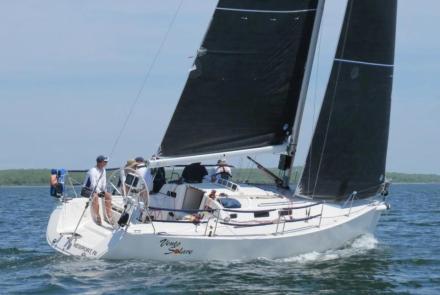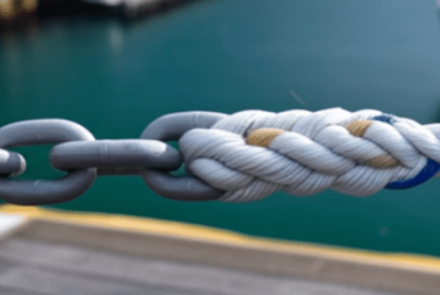The Stereo Doesn’t Work? Sometimes, one thing leads to another.
From the CCA School of Hard Rocks
...lessons learned in pursuit of the Art of Seamanship”
By Ernie Godshalk, Boston Station
November, 2022
Having left Golden Eye in Gothenburg while I returned to the US on business, I returned to find that the ship’s stereo, which we use frequently - e.g. a little opera at breakfast; towards the end of cocktail hour for a little salsa in the saloon; classical guitar at dinner; and finally a little Happy Dishwasher music – had given up after almost 20 years of faithful service. Why, when we weren’t even on board?
We had crossed into Norway by the time the stereo repair reached the top of my list.
I took down the radio panel and, with a multimeter in hand, was able to determine that the stereo wasn’t getting its 12 volts. When I improvised a 12-volt supply, it came to life. Progress, but a mystery remained behind the dead 12-volt supply line, which disappeared in the direction of the breaker panel.
|
The pump, after my attempt to remove the belt had, instead, broken it. |
Behind the breaker panel, I found the 12-volt supply line neatly labeled “stereo” by some dedicated electrician in the past but was initially perplexed to find that it led to a breaker for the bilge pump. That breaker was tripped and immediately tripped again when I tried to reset it. So, the mystery led to the bilge pump. (I later realized that the bilge pump is wired directly to the batteries, which the stereo needs, too, to keep its clock running even when the main battery switch is off, so that made sense.)
Inspecting the bilge pump led to a conclusion that it had packed up – likely due to a stuck float switch running dry and overheating – and was therefore tripping the breaker. The pump is a rusty old beast, long out of production (see photo) with an electric motor, an oscillating pump and a belt connecting the two. It lives in a confined space and has short hoses so I was eager to repair it rather than trying to replace it, which would undoubtedly require carpentry, plumbing and electrical work beyond my patience and pay grade. Speaking of which, in trying to remove the belt, I broke it and failed to find a spare aboard, so that added one more challenge.
I found that the problem was the motor, took it apart and – miraculously - was able to unfreeze it and reassemble it, so now all I needed was a new belt and I would once again have a functioning - albeit 20-year-old and rusty - bilge pump…and stereo.
These things always happen on Saturday. At our first port of call, three helpful Norwegian gentlemen were able to determine that boat yards there are closed on Saturdays. But I had the number of a boat yard a few miles away so called them. A recording in Norwegian and English said that the number was no longer in service, but calls were being taken by another number. I called that one and received an answer from a man who said he was at home but would meet me at the yard and see about ordering a new pump.
|
From L to R: Low-rise jeans, the author. Photo by Ann Noble-Kiley. |
It took us an hour of wandering around town to find the yard, which was clearly closed and abandoned. But, having talked to a live person, I persisted. We ducked around some derelict boats on the hard and found what appeared to be a car repair garage with three men looking into a car’s engine. We inquired about the boat yard and one of them, pointing to the ground, said, “Right here!” One of two other men came forward and introduced himself as the person to whom I had spoken earlier.
I showed him the photo I had taken of my pump. He whistled, as if seeing something rare and old, and exclaimed that he had NEVER seen anything like THAT before. He surmised that perhaps it was on an American boat and mentioned that the only American boat in Oslofjord was on the hard close by and that the third man was its owner. He was a friendly, portly, bewhiskered gentlemen; he looked at my photo and said, “I have one just like it on my boat and you are welcome to have it!” His boat turned out to be a 35 foot express cruiser that he had bought five years earlier in Chicago online from “Donate Your Boat”, at “a very good price”, and had shipped to Norway. He had been working on it ever since and hoped to get it into the water, “Perhaps next year” – I had my doubts. He escorted me aboard, raised the hatches under the aft cockpit and we both peered in. (See photo by Ann, who refers to him as “Low Rise Jeans.”) There was an exact copy of my pump, including rust. He again offered to give it to me, as he had no use for it. I declined but asked if he would be willing to sell me the belt. He said, “It is a gift”, and, with my new expertise, I showed him how to remove it intact.
Back aboard Golden Eye, I successfully installed the belt and got the bilge pump working but, in the process, dislodged the wires to the fresh water pump. Replacing them incorrectly and thereby bypassing the pressure shutoff, I ran the pump until, just before it stalled from overpressure, it blew a hose off – in an almost-inaccessible area behind the stove, which was another hour project. In repairing that, I pulled a wire to the sump pump out of its crimp connector, which led to additional repairs.
Ann asked me not to repair anything else.
But - the stereo works great!
Lessons learned:
- First, do no harm.
- Then, remember, you don’t have this much fun playing golf!
The Cruising Club of America is a collection of passionate, seriously accomplished, ocean sailors making adventurous use of the seas. All members have extensive offshore boat handling, seamanship, and command experience honed over many years. “School of Hard Rocks” reports, published by the CCA Safety and Seamanship Committee, are intended to advance seamanship and help skippers promote a Culture of Safety aboard their vessels







